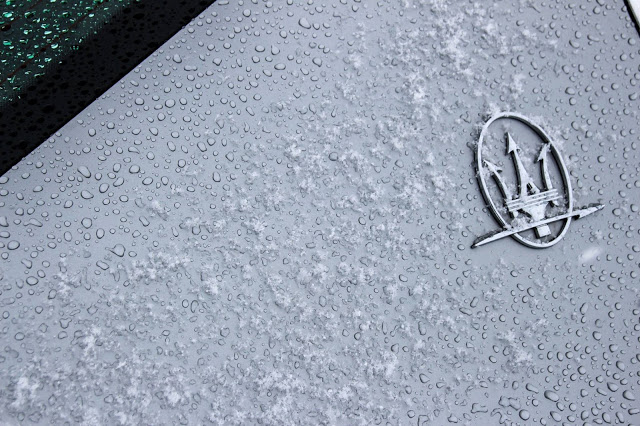
Glenfiddich Grand Cru: Whisky meets champagne barrel
With the Glenfiddich Grand Cru, the traditional Scottish company is breaking new ground. This 23-year-old single malt Scotch whisky spent a second maturation phase in French cuvée barrels, which gives it an additional freshness and balance.
Glenfiddich…

Absolute relaxation - Wellness in the Allgäu region
In the south of Bavaria you will find the beautiful region Allgäu, with its endless forests, an impressive view to the Alps and the cosy atmosphere, the region is one of the most important and largest holiday destinations in Germany. Time for…

Golf equipment included - the advantages of the Swiss Traveller Card
Every golfer knows it: You get used to your clubs and want to play with them - rental sets or other golf clubs are rather not an option. So if you want to play the many incredibly beautiful courses in the world, you have to take your golf equipment…

Range Rover Sport – Highclass Road Trippin’
Range Rover Sport
Range Rover – The Drive
Range Rover HSE – My Impression
Range Rover Sport HSE SDV6 Rating
Maserati Snow And Ice At The Chedi Andermatt
Maserati Snow And Ice – At The Chedi
The Maserati’s & The Chedi’s “Snow and Ice” Winter Experience
Maserati Snow Video
Ghibli vs Quattroporte and All Wheel Drive vs Rear Wheel Drive – two hard decisions when it comes to selecting your favourite Maserati Model in the snow.
As a passionate AWD Driver I found the Ghibli Q4 (AWD) the most handy and forgiving vehicle of the four. It is about half a meter shorter than the Quattroporte line and therefore has a wheelbase that is more compact. This shorter distance between the front and back wheels lets you control the Ghibli Q4 quite easily compared to the Quattroporte Q4. Even in Sport Mode and when turning off the Electronic Stability Program the Ghibli Q4 reacts almost immediately to your actions, whereas the Quattroporte Q4 with its nearly two tons, is a lot more inertial.
The Quattroporte Q4 took considerably longer until it swerved, but when it did, it was harder to keep control over the machine due to its weight.
Especially when drifting a slalom it is important that you don’t only concentrate on the curve that you’re in but you actually think about what happens two curves ahead. You need to know how the car is going to react to your stearing, accelerating and slowing down on snow and ice to be able to drift into the following curves flawlessly.
When you are about to hit a sharp curve, shift down and turn earlier and less than you would on a normal road. Having turned early, by the time you reach the curve the Maserati rear wheel drive slides nicely into the bend and doesn’t crash into the wall behind. By breaking in the curve – especially with the heavy Quattroporte – you transfer the Quattroporte’s weight from the rear to the front of the car to ensure your steering controls the car. As it is well-known, the performance of a rear wheel drive especially on ice is completely different to an AWD. It swerves a lot more, so you often have to countersteer to keep it on track.

SIHH – IWC Schaffhausen, Come Fly With Me!
SIHH 2016 With IWC Schaffhausen
Fasten your seatbelts and let me take you on a journey to Geneva, where IWC Schaffhausen presented their new Pilot’s Watch collection. Flying has always fascinated me and as it was a gentlemen’s sport in the early 1930s it’s a perfect topic to write about.
The dream of flying and the role of IWC Schaffhausen
Scientists always knew that riding horses, walking and shipping will not be the future means of transportation. They knew that we are able to reach different spheres. Their ingenuity encouraged them to shatter the rules and to bypass the solid understanding of science. They knew there is more to discover – the sky wasn’t the limit.
The term “aviation” as we know it today came up first in 1863 by a French pioneer and the modern aeroplane with the characteristic tail we know today was established in 1909. From then on the myth of modern flying was born.
In its early years flying was a gentlemen sport performed by well-educated and rich men and became very popular in the 1930s.
This is the time when IWC Schaffhausen – a pioneer in producing Pilot’s Watches started to produce their very first Pilot’s Watch. The first IWC Pilot’s Watches of the 1930s and 1940s set technical benchmarks, and their dial design determined the overall appearance that has remained so distinctive to this day. During the pioneering days of aviation, most pilots had to navigate with the help of pocket watches, because special wristwatches for pilots were still few and far between. By contrast, the first Special Pilot’s Watch, built by IWC in 1936, already featured a rugged glass, a rotating bezel with an arrowhead index for instantaneous legibility and an anti magnetic escapement, together with high contrast, luminescent hands and numerals.
From 1940, IWC started producing the Big Pilot’s Watch in accordance with military specifications. It featured an IWC-manufactured watch movement and large seconds hand. With a case measuring 55 millimetres in diameter and weighing in at 183 grams, until 2016 it was the most voluminous wristwatch ever made by IWC. In terms of precision, it met chronometer standards as well as the technical demands placed on a military navigation or observer’s watch back in those days. Amazing, isn’t it?
This original 55 mm watch was also the inspiration for the new IWC Pilot’s Watch collection presented at the SIHH 2016 in Geneva. IWC tried to stick to their heritage and produced a modern and elegant collection which still reminds you of the original watches produced in the 40ies. Let’s phrase it like Georges Kern (CEO of IWC Schaffhausen) in one of his interviews: “Why always asking for novelties instead of improving the existing products?” (Sonntagszeitung) or as IWC says it: “Be Original”.
The life of a pilot called Antoine de Saint-Exupéry & my favourite watches
IWC Big Pilot’s Watch Annual Calendar Edition “Le Petit Prince” Ref. IW502701
Since 2006, IWC has been honouring the life’s work of French poet and pilot Antoine de Saint-Exupéry with special editions of its Pilot’s Watches. Saint-Exupéry was already a legend in his own lifetime. People are fascinated as much by his books as by his adventurous life and his inherent passion for flying.
Saint-Ex is definitely one of my favourite writers. Not only because he was a pilot, but much more about the wonderful way how he tells the stories. I’m sure you all know his famous book “Le petit prince”.
The recap of my journey matches perfectly with the values of flying. Flying is a sign for absolute freedom, elusiveness, spirit of discovery and harmony. We adore flying because it frees our mind and it lets all our worries fly away – and that’s what I experienced at the SIHH 2016!PS. Here some photos with Celebrities, the quality of the images doesn’t match my blog, and therefore I decided to put them on an external drive in case you want to have a look: